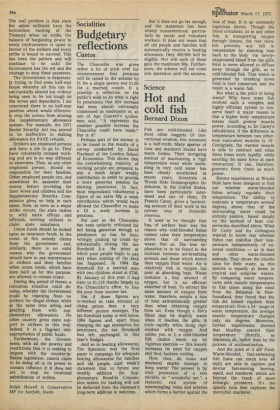Hot and cold fish
Bernard Dixon
Fish are cold-blooded. Like most other nuggets of conventional wisdom, this statement is a half-truth. Many species of tuna and mackerel sharks have warm bodies. Their intriguing method of maintaining a high temperature even while swimming in very cold water has been closely scrutinised in recent years. Scientists at Woods Hole Oceanographic Institution, in the United States, have been particularly interested and one of them, Dr Francis Carey, gives a fascinating account of their work in the current isue of Scientific America.
It used to be thought that loss of surface heat was the reason why cold-blooded fishes cannot raise their temperature above that of surrounding water. Not so. The true explanation is to be found in the contrast between air-breathing animals and those which derive their oxygen from water. Air is relatively rich in oxygen but poor at absorbing heat. Water contains a, tiny amount of oxygen, but is an efficient absorber of heat. To extract the same amount of oxygen from water, therefore, entails a loss of heat astronomically greater than when obtaining oxygen from air. Even though a fish's blood may be slightly warm when it reaches the gills, it cools rapidly while being repl enished with oxygen. And unlike you or I, a cold-blooded fish cannot warm up by vigorous exercise — this merely increases its need for oxygen and thus hastens cooling.
How, then, do tunas and mackerel sharks manage to keep warm? The answer is by their possession of a rete nurable, or "wonderful net ", a fantastic, rich system of intermingling veins and arteries which forms a barrier against the loss of heat. It is an extremely ingenious device. Though the blood circulates, as in any other fish, in transporting oxygen through tissues, the rete mirabile prevents any fall in temperature by shunting heat back to the body via newlyoxygenated blood from the gills. Heat is never allowed to diffuse away through the gills, as in cold-blooded fish. That which is generated by breaking down food is here conserved, and the result is a warm fish.
But what is the point of being warm? Why have some fish evolved such a complex and highly efficient system to conserve heat? A major reason is that a higher body temperature means much greater muscle power. According to Dr Carey's calculations, if the difference in temperature between two otherwise equivalent muscles is 10 Centigrade, the warmer muscle is able to contract and relax three times more rapidly, while exerting the same force at each contraction. It can, therefore, generate three times as much power.
Recent experiments at Woods Hole have been designed to find out whether warm-blooded fishes actualy regulate their temperature. The ability to maintain a temperature several degrees above that of the surrounding water could be entirely passive, based simply on the method of heat conservation described above. What Dr Carey and his colleagues wanted to know was whether fishes can stabilise their temperature independently of external conditions — as in man and other warm-blooded animals. They chose the bluefin tuna for their study, as this species is equally at home in tropical and subpolar waters. By comparing water temperatures with muscle temperatures in fish taken along the coast from the Bahamas to Newfoundland, they found that the fish did indeed regulate their temperature. Over a 24' range of water temperature, the average muscle temperature changed only six degrees. Moreover, further experiments showed that bluef ins control their temperature directly, as mammals do, rather than by the process of acclimatisation.
And the point of it all? Food. Warm-blooded, fast-swimming fish (tuna can reach over 40 mph) are able to capture and devour fast-moving herring, squid, and mackerel, which are beyond the reach of more lethargic predators. It's the speedy tuna that captures the mercurial mackerel.


































 Previous page
Previous page